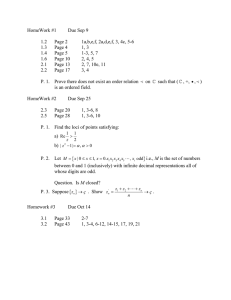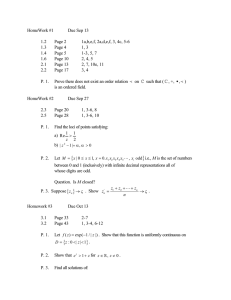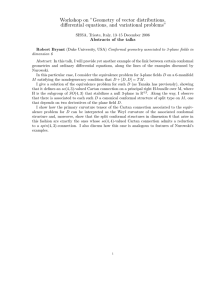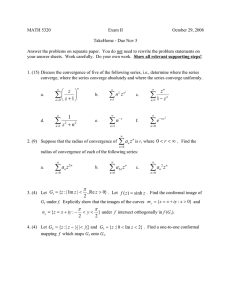On Scale and Conformal Invariance in Quantum Field Theory y
advertisement
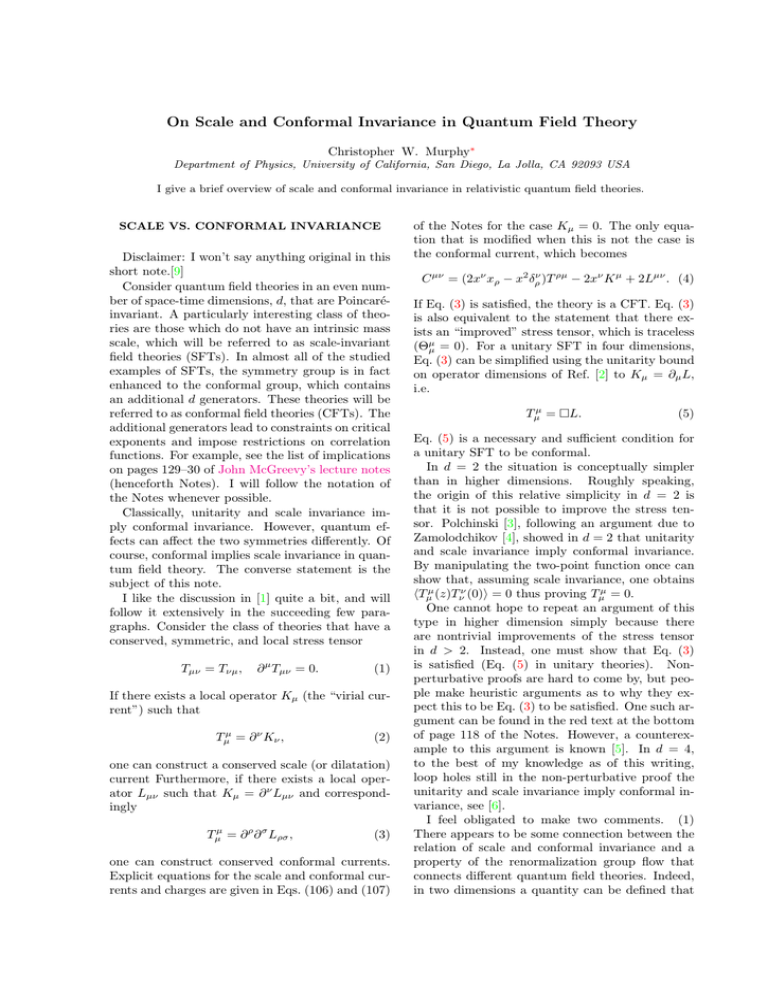
On Scale and Conformal Invariance in Quantum Field Theory Christopher W. Murphy∗ Department of Physics, University of California, San Diego, La Jolla, CA 92093 USA I give a brief overview of scale and conformal invariance in relativistic quantum field theories. SCALE VS. CONFORMAL INVARIANCE Disclaimer: I won’t say anything original in this short note.[9] Consider quantum field theories in an even number of space-time dimensions, d, that are Poincaréinvariant. A particularly interesting class of theories are those which do not have an intrinsic mass scale, which will be referred to as scale-invariant field theories (SFTs). In almost all of the studied examples of SFTs, the symmetry group is in fact enhanced to the conformal group, which contains an additional d generators. These theories will be referred to as conformal field theories (CFTs). The additional generators lead to constraints on critical exponents and impose restrictions on correlation functions. For example, see the list of implications on pages 129–30 of John McGreevy’s lecture notes (henceforth Notes). I will follow the notation of the Notes whenever possible. Classically, unitarity and scale invariance imply conformal invariance. However, quantum effects can affect the two symmetries differently. Of course, conformal implies scale invariance in quantum field theory. The converse statement is the subject of this note. I like the discussion in [1] quite a bit, and will follow it extensively in the succeeding few paragraphs. Consider the class of theories that have a conserved, symmetric, and local stress tensor Tµν = Tνµ , ∂ µ Tµν = 0. (1) If there exists a local operator Kµ (the “virial current”) such that Tµµ = ∂ ν Kν , (2) one can construct a conserved scale (or dilatation) current Furthermore, if there exists a local operator Lµν such that Kµ = ∂ ν Lµν and correspondingly Tµµ = ∂ ρ ∂ σ Lρσ , (3) one can construct conserved conformal currents. Explicit equations for the scale and conformal currents and charges are given in Eqs. (106) and (107) of the Notes for the case Kµ = 0. The only equation that is modified when this is not the case is the conformal current, which becomes C µν = (2xν xρ − x2 δρν )T ρµ − 2xν K µ + 2Lµν . (4) If Eq. (3) is satisfied, the theory is a CFT. Eq. (3) is also equivalent to the statement that there exists an “improved” stress tensor, which is traceless (Θµµ = 0). For a unitary SFT in four dimensions, Eq. (3) can be simplified using the unitarity bound on operator dimensions of Ref. [2] to Kµ = ∂µ L, i.e. Tµµ = L. (5) Eq. (5) is a necessary and sufficient condition for a unitary SFT to be conformal. In d = 2 the situation is conceptually simpler than in higher dimensions. Roughly speaking, the origin of this relative simplicity in d = 2 is that it is not possible to improve the stress tensor. Polchinski [3], following an argument due to Zamolodchikov [4], showed in d = 2 that unitarity and scale invariance imply conformal invariance. By manipulating the two-point function once can show that, assuming scale invariance, one obtains hTµµ (z)Tνν (0)i = 0 thus proving Tµµ = 0. One cannot hope to repeat an argument of this type in higher dimension simply because there are nontrivial improvements of the stress tensor in d > 2. Instead, one must show that Eq. (3) is satisfied (Eq. (5) in unitary theories). Nonperturbative proofs are hard to come by, but people make heuristic arguments as to why they expect this to be Eq. (3) to be satisfied. One such argument can be found in the red text at the bottom of page 118 of the Notes. However, a counterexample to this argument is known [5]. In d = 4, to the best of my knowledge as of this writing, loop holes still in the non-perturbative proof the unitarity and scale invariance imply conformal invariance, see [6]. I feel obligated to make two comments. (1) There appears to be some connection between the relation of scale and conformal invariance and a property of the renormalization group flow that connects different quantum field theories. Indeed, in two dimensions a quantity can be defined that 2 undergoes a monotonically decreasing renormalization group flow from a CFT in the UV to a CFT in the IR. This is aforementioned result of Zamolodchikov [4], which Polchinski used to prove scale implies conformal in d = 2. In d = 4, an analogous quantity has not been found yet, but there weaker condition that there exists a quantity, which is a larger in the UV than in the IR, has been shown. (2) It is useful to study a quantum field theory on a curved background with space-time dependent couplings so that the metric γµν (x) and couplings g I (x) act as sources for the stress tensor and operators (labelled by I) in the Lagrangian, respectively. These techniques have been used to obtain many of the results discussed here, see [7] for recent analysis. ∗ Electronic address: cmurphy@physics.ucsd.edu [1] A. Dymarsky, Z. Komargodski, A. Schwimmer, and S. Theisen (2013), 1309.2921. [2] B. Grinstein, K. A. Intriligator, and I. Z. Rothstein, Phys.Lett. B662, 367 (2008), 0801.1140. [3] J. Polchinski, Nucl.Phys. B303, 226 (1988). [4] A. Zamolodchikov, JETP Lett. 43, 730 (1986). [5] S. El-Showk, Y. Nakayama, and S. Rychkov, Nucl.Phys. B848, 578 (2011), 1101.5385. [6] A. Dymarsky, K. Farnsworth, Z. Komargodski, M. A. Luty, and V. Prilepina (2014), 1402.6322. [7] I. Jack and H. Osborn, Nucl.Phys. B883, 425 (2014), 1312.0428. [8] J.-F. Fortin, B. Grinstein, C. W. Murphy, and A. Stergiou, Phys.Lett. B719, 170 (2013), 1210.2718. [9] I have actually made a contribution to this field though. See [8] if you’re really interested.

